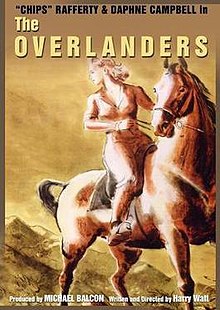The Overlanders (film)
| The Overlanders | |
|---|---|
 |
|
| Directed by | Harry Watt |
| Produced by |
Michael Balcon Ralph Smart (associate) |
| Written by |
Harry Watt Ralph Smart |
| Starring |
Chips Rafferty John Nugent Hayward Daphne Campbell John Fernside Peter Pagan Helen Grieve Jean Blue |
| Music by | John Ireland |
| Cinematography | Osmond Borradaile |
| Edited by |
Inman Hunter Leslie Norman |
| Distributed by |
British Empire Films (Aust) Ealing Studios (UK) Umbrella Entertainment (Aust) Universal Pictures (US) |
|
Release date
|
27 September 1946 (Australia) 1947 (France) |
|
Running time
|
91 minutes |
| Country | United Kingdom Australia |
| Language | English |
| Budget | ₤40,000 or £80,000 |
| Box office | ₤160,000 (Australia) 1,143,888 admissions (France) £250,000 (total) |
The Overlanders is a 1946 British film about drovers driving a large herd of cattle 1,600 miles overland from Wyndham in Western Australia through the Northern Territory outback of Australia to pastures north of Brisbane, Queensland during World War II.
The film was the first of several produced in Australia by Ealing Studios, and featured among the cast Chips Rafferty.
In 1942 the Japanese army is thrusting southwards and Australia fears invasion. Bill Parsons becomes concerned, and leaves his homestead in northern Australia along with his wife and two daughters, Mary and Helen. They join up with a cattle drive heading south led by Dan McAlpine. Others on the drive include the shonky Corky; British former sailor, Sinbad; Aboriginal stockmen, Nipper and Jackie.
The cattle drive is extremely difficult, encountering crocodiles, blazing heat and other dangers. Mary and Sinbad start a romance. Dan speaks out against Corky's plans to develop the Northern Territory.
The film came about because the Australian government were concerned that Australia's contribution to the war effort was not being sufficiently recognised. They contacted Britain's Ministry of Information, who in turn spoke with Michael Balcon at Ealing Studios, who was enthusiastic about the idea of making a film in Australia. He sent Harry Watt out to find a subject. Watt travelled the country as an official war correspondent and guest of the Australian government. He would spend eighteen months in Australia making the film.
Watt decided to exploit the Australian landscape by making a film set entirely outdoors. When visiting a government office in Canberra to advise on making documentaries, he heard about an incident in 1942 when 100,000 cattle were driven 2,000 miles in the Northern Territory to escape a feared Japanese invasion.
Watt was only allowed to import four technicians from Britain to assist – editor Inman Hunter, cinematographer Osmond Borradaile, production supervisor Jack Rix and camera operator Carl Kayser. The rest of the crew were drawn from Australia. Sound Recording Engineer: Beresford Charles Hallett
...
Wikipedia
